For years now, with each new major Cogmind release I’ve analyzed the player stats reported for runs in the prior release (I covered this process in the latter half of this article before). Back when Cogmind came to Steam here on the blog I did take a close look at player metrics with a particular eye towards comparing any differences between Steam and non-Steam players, but other than that time the analyses have generally been posted to the forums in this thread, where they became increasingly detailed with each release, then later started looking more closely at the new features of each particular release. Previous stat analysis links are also archived at the bottom of the leaderboards.
Cogmind Beta 9 was special in that the scoresheet underwent a major rewrite to include not just thousands of data points per run, but up to tens of thousands, plus even more categories of run info. So with a variety of potential new topics to look at I decided to put this one on the blog since it’s longer than usual and relates back to some of the features I’ve covered here before. The fact that the architecture was changed did require rewriting all my supporting code for stat exporting, so this is somewhat late in coming, but it’s finally here :)
One segment that I’ve always included in the past is “meta stats” surrounding player devices, input, and preferences, but I’m not going to be compiling these for now since there really hasn’t been much shifting in these numbers over the years since Cogmind was added to Steam. If you’re interested in user stats like this you can refer back to earlier reports for an understanding of more or less where things stand (this might be even more interesting in the Steam vs. non-Steam comparison, though there has also been some shifting since then as it was over three years ago :P).
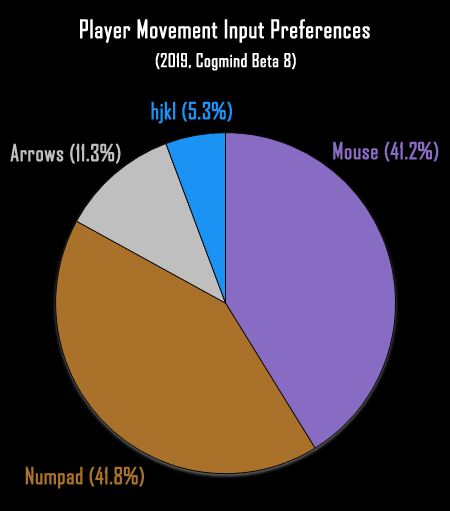
Graphing one of the more interesting general statistics, the number of players using each type of movement input. (hjkl has gradually shrunk over the years, I’m afraid, as more non-hardcore roguelikers discover Cogmind :P)
The Stats are Back!
With the crazy level of detail offered by our new scoresheets they’ve become an even more comprehensive and interesting way to examine exactly how each run progressed, though in most cases here we’ll be focusing on more meaningful aggregate stats rather than per-map data from individual runs. Even without including per-map data (which would multiply this by a huge factor), the run data we’re looking at below consists of 9,781,477 data points!
The full archived Beta 9 leaderboards can be found here, with scoresheets for all runs accessible at the bottom.
A total of 9,743 runs were submitted, though 375 have been excluded due to earning a score less than 500, and another 1,437 for being from special modes/events, leaving us with 7,931 runs to analyze for aggregate stats. (Special events will be looked at in a separate section--there were many during the Beta 9 cycle!) There were far fewer runs not even making it out of the first area than in previous releases, likely due to Beta 9 putting the difficulty menu front and center to raise awareness about that option and getting more people who would prefer easier modes to play one of those.
920 unique named players submitted at least one qualifying Beta 9 run, an average of 8.6 per player, lower than the last few betas, perhaps due to the fact that the Beta 9 series in particular was by far the longest ever with mostly special event releases rather than primary content updates (so people allocated more runs to those rather than the regular game). Beta 9 spanned a period of over eleven months and included a total of seven updates, half of which were special modes! Aside from those and the first flagship release, the others were mostly minor updates.
Difficulty
Beta 9 was the first release to make the difficulty selection menu the first thing new players see, and also forced all existing players to explicitly set their difficulty level rather than simply defaulting to the intended most difficult “Rogue” setting. As such we ended up with a huge shift in the number of players using other modes. (It clearly makes a big difference to put important options up front rather than just in the options menu!)
As you can see in the graph here, the number of players using a non-Rogue mode jumped from a mere one-tenth to over a third!
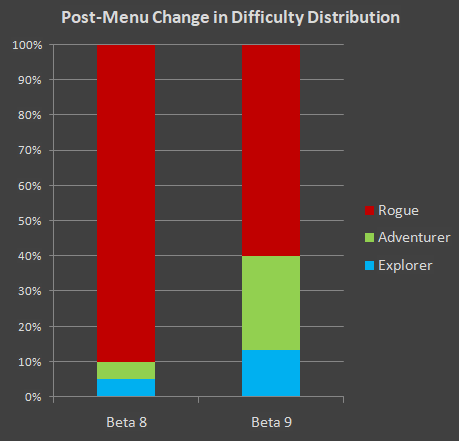
Beta 8 defaulted to the hardest difficulty mode and only had a tutorial tip notifying players it could be changed in the options menu; Beta 9 forced players to choose a difficulty setting at the start. The effect is telling.
The majority still go for the primary permadeath-enforced roguelike mode, but it’s good to see that many others are now more able to enjoy the game as they prefer. Anecdotally, some people also use lower difficulty modes to practice and learn, gradually moving up as their skill improves. The stats show that overall Rogue mode players have more hours of experience with the game, although not by a large margin! The average number of hours among Rogue players (63.7) is double that of other difficulties, although this value is skewed upward by the core set of players who tend to have many hundreds of hours. By comparison the median number of hours ranges from about 10~12 across all difficulties.
Wins
The win rate among Beta 9 Rogue runs was 5.7%, compared to 1.2% in Adventurer and 3.5% in Explorer. Note that many runs on Adventurer/Explorer difficulties continued further than the submitted score, because permadeath is optional and players can load a previous game states, but data for runs loaded in such a way is not uploaded. Therefore more runs using those modes probably did go on to win, but it was after additional attempts. (It’s not unheard of for a player to load many hundreds of times during a single run! It’s really quick and there’s a hotkey, so… :P)
Not everyone is attempting to win all of their runs, however, or at least add extra challenge by going for more difficult win types, or challenging themselves in other ways that might more likely result in a loss. So a more accurate win rate probably looks at the percentage of players who had at least one win during the Beta 9 cycle. Looking at those results we see that 86 players had at least one win (out of 920), or 9.3%. The actual percentage would be higher for Adventurer/Explorer runs since those could go on to load and improve their run, though we don’t know how much higher. We can, however, calculate the real percentage of Rogue players who won: 12.5%. Not bad.
396 wins were submitted by alice_fexa (55), Alexbot (39), GJ (26), 3.14 (24), cptwinky (23), int Ascended=0; (17), Joshua (12), lsend (11), Pimski (11), aoemica (9), sideriver8 (9), Stryker (9), Dhoby_Ghaut (8), TBExtent (7), Vectis (7), Michael (6), MTF (6), PlasticHeart (6), Ben’n’Dan (5), Adraius (4), Ape (4), Fleshy Vegetable Bird (4), muxecoid (4), Trione (4), UlyssesB (4), Finestep (3), Kyzrati (3), Terminus (3), Zailor (3), Zyalin (3), bugsniper (2), Cipherpunk (2), Ctrl_Alt_X (2), Dusanh (2), Gobbopathe (2), kerapace (2), Magellan (2), NoNeedToExplain (2), octapi (2), Solar Sloth (2), Torako (2), zzxc (2), Airus, ApolliniaD, BillyNate, BinarySpace, BlackCaro, Chad, Cracklepappy, Decinym, derk, Dullahan, Exp. Geonium Core, GridBugBear, Horse, IceBox, inSANE, Jolley, Kenzurith, Khal42, Kiks, LordVenom1, Michael, MitchellFJN, ModulinMyGlobulin, Nalzok, Nori, Omewes, Phillammon, Plexion, RNGesus, Rumbl3, Sandwich, toad3k, Tone, Tough2Name, TravelDemon, viper, VoodooWoodoo, Wayward Satellite, whitenitro0, Xax, Xeram, Xii, YppY.
The average duration of a winning run was 4 hours and 44 minutes. (This wasn’t significantly different from median of 3h 57m.) The fastest win goes to Zyalin, for a 25m 55s run, and the longest win goes to Trione, clocking in at 23h 12m 33s!
Zyalin’s run was a 2,916-action pacifist speed run that took 1,179 turns, but turn-wise the fastest speed run win was by Alexbot (681 turns!!!) followed by… me :P (908 turns)
Trione’s epic journey traveled through 44 maps (tying for the maximum with several other players), destroying a lot of bots but keeping alert low while doing a fair bit of RIF hacking and going on to get an extended ++ ending. The next-longest run behind that was Tone’s 20-hour combat romp.
(Remember that Cogmind-recorded play time is not equivalent to Steam’s, since the latter includes idling whereas Cogmind does not, so we actually have accurate numbers here.)
By far the highest number of kills goes to Pimski’s 300,886-point Access farming run, destroying 2,212 bots (including 1,723 hostiles) in the top run of the cycle. Almost all of the kills were recorded in Access after triggering high security and eventually reaching a ridiculous peak influence of 44,607… As of Beta 10, farming 0b10 maps is no longer a thing due to new mechanics, but this was an impressive show of what was possible with the right build and tactics, using a fast but powerful build to kite everything at range and take minimal damage.
Deaths
So all those runs that didn’t win… that’s the 7,535 deaths :P. And for the first time we actually have detailed data on the cause!
I should preface this by saying that it’s mostly for fun, however, and not nearly as meaningful as in other roguelikes, since due to attrition the cause of death in Cogmind is just the final nail in a very big coffin built over a long period, simply what happens to finish off the player at the end of what is probably multiple mistakes/poor decisions or any number of things that could’ve caused the same result in the Very End as recorded. (With your average roguelike the underlying cause of death is most likely more immediately associated with whatever the player was doing at the time, since it’s not uncommon to be at or near full capabilities for many encounters.)
Of course there are some more special causes of death, and we’ll take a look at those, too.
2.2% of deaths (163) were reported as simply “Core Destroyed,” a generic catch-all for when the actual cause was unable to be determined for some reason, or was a highly specific type of death that doesn’t fit into other categories but also lacks any corresponding unique text.
Naturally the majority of deaths can be attributed to hostile bots, especially the common 0b10 Unaware. Some special cases include Crushers, accounting for 48 deaths (0.6%), and Trackers with 12 kills (0.16%).
Assembled ended 314 runs (4.1%), 27 of those being of the G variety. As one might expect, most such runs (75.5%) ended in the Mines, with others generally deep in the caves, but still a decent amount (7.3%) in Exiles due to evil players turning on the friendly folk there and suffering the consequences. Interestingly one run in each Factory and Research was lost to Assembled due to events that might occur there.
While the majority of NPCs in Cogmind are friendly, a lot of players are not so friendly when it comes to meeting NPCs, where you of course have two outcomes: player wins and gets sweet loot, or player suffers a horrible death… (the following section uses common abbreviations in most cases to openly discuss the data without as much worry about spoilers)
23 Cogminds were killed by a Hero of Zion (NK-0LA’s the most deadly, followed by 99-TNT), 19 died to YI-UF0 (a tough early encounter since at the time you’re relatively weak and they’re both aggressive and nade-happy), and 8R-AWN trashed 50 Cogminds--not surprising since he’s quite an out-of-depth opponent when you meet, but some players just insist on trying to loot their gear :P (13 died to EX-BIN’s DAS Turret, and 4 to the Exiles themselves).
No one has a recorded death from Zh/S/P, likely because they’re not all that powerful and tend to run away themselves once damaged.
Also no deaths to GM, and somewhat surprisingly none to W, although in that case he almost always has a ton of escorts who could easily finish the job and steal the kill.
One powerful NPC without much in the way of escorts that tends to kill a lot of players is Z-Im, responsible for ending 32 runs.
No one died to FFF (easy to run--or limp--away from :P), and only 12 deaths to MC (also lots of allies to finish the job). Arch killed 5 players (not too hard to retreat from that fight if necessary, although few people visit or even know about that area to begin with).
Of course lots of NPCs also died at the hands of players… Here’s the complete chart, hidden behind a link because this includes all major NPCs (plus a bunch but not all minor ones--very spoilery overall, so skip it if you like and I’ll just summarize here:
- Z-Im/Im was killed the most, which makes sense because they’re at a mid-game gateway to a variety of content, and therefore both relatively easy to reach and tempting to take on.
- The main boss was killed quite a lot, since most extended runs aim for that as one of their goals.
- YI-UF0 also died quite a bit, mainly because they’re not always hostile (i.e. easier to ambush), and one of the earliest NPCs you can meet.
- The longest extended runs tend to take out quite a few “A”-type NPCs, since that particular faction has many.
- 8R-AWN killed lots of players, but players also killed lots of 8R-AWN :P (a bunch of EX nerds were killed as well, but there was an issue with the scoresheet reporting on them that was only discovered and fixed later in Beta 9, so I just removed all of them from the data--for these purposes the main NPC of importance in that area is 8R-AWN anyway)
- Players also took out a fair number of heroes, a common hunting target among some veterans for their unique parts.
Valguris (spoilers!) apparently holds the record for killing the most NPCs in a single run: 15.
Back to causes of player death…
168 deaths (2.2%) were attributed to the environment, the most common being cave-ins (83 deaths), followed by exploding machines (57, regardless of what triggered the explosion in the first place), traps (19), and chain reactions (9), i.e. power source detonation as a side effect of electromagnetic damage.
107 deaths (1.4%) were self-inflicted (generally unintentional, although players definitely sometimes choose to go out with a bang), 68 with regular launchers, 31 via explosive machines, 5 with ST, 3 with the YOLO Cannon, and… drum roll, please… 1 with SST.
There were a couple unique deaths, once to a singularity, and once to system corruption. The latter is hard to get except intentionally, so I checked the scoresheet for more details and sure enough it looks like they were just sitting in Waste getting blasted by the EMP discharge until death.
27.4% of runs (2,063) ended in self-destruction.
The majority of deaths, 67.5% (5,087), were naturally caused by other bots.
In summary:
Builds
Beta 9 came with the new option for players to have their HUD display an analysis of what type of build they’re currently running, information initially added to help contextualize mid-run stat dumps (and later included as part of the Steam Rich Presence update). Related entries in scoresheets now let us see build type frequency and transitions throughout each run. (As a reminder, build classification specifies a base class representing the core focus of one’s build, and this may be further prefixed by a special class modifier that describes additional abilities. The system was explained in more detail in this blog post, and for convenience/general interest, at the end of this section is a reference describing how most classes are defined.)
There is a lot of build data, including everyone’s primary build for each map, and a list of all builds across the run and how much of the run they used it for, but for this first section here I’m only looking at their most used build across an entire run, and ignoring any runs that did not make it to at least a depth of -6 (since there isn’t quite as much variety in early maps while players are still accumulating slots and gear, and differentiating their builds).
Within those restrictions, Beta 9 runs included 67 different build combinations out of a theoretical maximum of 208. The top 10 most common were as follows:
Not unexpectedly, Mutants, Haulers, and Scavengers top the list. Respectively, these are the fairly random builds with no particular focus, builds with huge inventory capacity, and builds heavily dependent on salvage from other robots.
From the restricted pool it’s also interesting to see those builds that were only ever maintained as a primary build once:
Some interesting combos in there :)
Examining purely base class prevalence, there aren’t really any surprises on this list (and all possible base classes are represented here except for one):
Also here’s the prevalence of each special class modifier (all but two are represented here, and a significant chunk (39%) have no modifier at all):
Haulers are quite common, but Scavengers still win out at least in part since the majority of runs don’t win, and as they gradually get worn down over time are probably replacing more and more parts with those from fallen enemies rather than holding onto as many parts originally sourced from caches. I think we’ll be seeing fewer “Hauler”-designated builds in future releases after expected changes to reduce inventory sizes (though the definition of a “Hauler” will also likely change as a result).
The above list is also a pretty good indicator of the portion of players who prefer a hacking style, which we haven’t previously had an easy way to determine. According to the list, 11.1% of players had a strong focus on machine hacking, while 3.7% focused on bothacking.
Again, all this is only looking at each run’s most common build, and only for runs that reached at least -6.
Examining the same set of charts for only the dominant class on the final map for winning runs highlights some interesting differences, of course. The number of different build combinations ends up about the same, however, at 66:
Pure Mutant still makes it into the top 10, but is much lower, and various hacker/wizard builds make up a greater portion of the list. Also there are no Hauler builds in sight :P (by then players have generally transitioned into their final build and have a reduced need for inventory, or at least a heavier concentration into a single build type enough to override the possibility of being considered a primary hauler).
Again for fun, here’s the dominant builds that only appeared once:
Base class prevalence shows a much lower ratio of Mutants (37.1% vs 69.6% for the most-used base class across all runs), and a greater emphasis on builds with less of a combat focus, e.g. fast/stealthy/hacking Cogminds, which are favored for less risky wins:
The dominant class mod on winners’ final map is overall similar to the earlier class mod chart, with a few specific noticeable differences:
- At this point in the run players have evolved many slots and likely focused on a particular build type, thus only 6.6% of runs had no special modifier
- Haulers have only a minimal presence here
- The Alien modifier plays a more obvious role, something that can only happen in the late game, and is likely among those players trying to increase their power enough to take on the extended game
- Lots more Generators, for those players who were building up large stores of energy to power the best shields and/or experimental weapons
- Machinist is here but didn’t even appear on the general list (earned by having fabricated a decent chunk of your own build, which is only likely to happen by the late game) (note that Mechanic and Machinist are actually the same thing--the class mod was renamed to the latter in the middle of Beta 9, and I forgot to take that into account and merge the two when compiling these stats… so those bits are a little off, but not a huge deal since it’s a less common class to begin with; such is the problem with waiting months to do the stat analysis after a very long beta xD)
- Compared to earlier, a whopping 33.3% of builds primarily focused on machine hacking, and 5.1% on bothacking (hacking good)
Below are the current definitions of each class term, some redacted to avoid spoilers.
Base classes:
- Sprinter: Very fast flying build with low infowar
- Scout: A flying infowar build
- Ninja: As Scout, but also using a melee weapon and at least one stealth-related utility
- Assassin: Melee combatant supported by multiple infowar abilities
- Gladiator: Multiple slots devoted to melee weapons and supporting utilities
- Skirmisher: Low-weapon ranged combat build supported by multiple infowar abilities
- Gunner: Three or more weapon slots plus utilities with a more offensive emphasis
- Tank: Three or more weapon slots plus utilities with a more defensive emphasis
- Executioner: Large number of mostly non-melee weapon slots
- Bomber: Combat build that mostly uses launchers, and currently possesses at least one
- Sniper: Combat build with minimal weapon slots but increased sight range, great accuracy, and a long-range weapon
- Golem: [REDACTED]
- Mutant: Doesn’t qualify for any of the other classes
Special Class Modifiers:
- Hacker: Good at machine hacking, essentially via hackware
- Wizard: More extreme version of Hacker
- Bothacker: Installed RIF, have couplers attached, and own any Datajack (more likely with RIF upgrades)
- Botlord: More extreme version of Bothacker, requires also having several RIF upgrades
- Trapper: Own at least one trap-producing utility and a number of traps (get a bonus towards this with attached Structural Scanners)
- Hauler: Large inventory capacity
- Generator: At least three power slots generating a decent amount of energy
- Pyromaniac: Volley capable of significant total heat transfer
- Infiltrator: Multiple defensive infowar and other stealth-like utilities
- Scavenger: Many parts salvaged from other robots
- Machinist: Many parts built at a fabricator (originally called “Mechanic” early in Beta 9, and later renamed to avoid confusion)
- Commander: Leading a number of directly controllable allies
- Derelict: Many parts of derelict origin
- Messiah: [REDACTED]
- Alien: [REDACTED]
Obviously many of the above scenarios can apply to the same build, but the one chosen is that which most applies, since each uses a formula to measure its degree, which is then directly compared to all others.
RIF (Relay Interface Framework)
The ability to upgrade your robot hacking system with additional permanent abilities was one of the big new things in Beta 9, so naturally we want to look at some numbers associated with that.
For one, we might expect there to be a higher percentage of player deaths inside Garrisons, at least somewhat, given that repeated trips to Garrisons are necessary to continue leveling up. Of course, one factor working against this assumption is that for RIF users Garrisons actually become a safer place than other parts of the complex (easier to control alert, mostly predictable layout, and local access to coupler resources for more hacking). At the same time, greedy bothackers are also more likely to try to Garrison dive even when in a weakened state, adding to the risk of dying…
14.3% of runs (1,133) entered at least one Garrison, a notable increase over previous versions (9.5% did so in Beta 8). 5.0% of Cogminds (398) died in a Garrison, also more than in Beta 8 (2.7%) and Beta 7 (3.6%). Greedy indeed :)
10.1% of runs (798) used at least one RIF Installer, 74.9% of those (598) doing so at or below a depth of -8, even higher than the two-thirds when RIF was first introduced in Beta 7! This is likely due to both players getting better at finding the first Garrison, and also getting really eager to have their first RIF upgrade as early as possible to stack as many as possible in a single run (also later Garrisons can get more and more challenging). Even 8.1% of RIF runs used their first installer in a Garrison off -9/Storage, which itself is fairly dangerous. (33 runs didn’t install RIF until -5 or higher, in some cases due to gaining access to unique couplers only by then, or for some other strategic purpose.)
47.1% of RIF runs (376) gained a new ability at least once (i.e. used two or more RIF Installers). The average number of RIF abilities gained per depth on RIF runs was 0.62 (only counting from -8). The highest number of upgrades in a single run was a three-way tie between 3.14, Joshua, and Valguris, each of whom reached 11. 31 of the runs that did not gain any abilities at all went on to win (that’s 35.2% of winning RIF runs)--even just a basic RIF install comes with some very useful features, after all!
The average RIF run hacked 21 bots, far higher than Beta 7 and 8 where the average was 9 bots in both cases. RIF abilities really encouraged people to spec their builds and strategies into bothacking! A number of different players hacked hundreds of bots per run, with Joshua hacking the most in a single run: 393! (again blowing previous records--124 and 146--out of the water). Among those runs where any bots were hacked at all, the median count was 13 (naturally much lower since a lot of runs don’t make it as far, or aren’t entirely focused on the actual hacking part).
RIF users attached an average 8.4 couplers per run, with Tone attaching the most in a single run: 102. On the opposite end of the spectrum, 35.3% of runs (282) never used any Relay Couplers at all (either because they died, or were using pure RIF abilities).
New Mechanics
Treaded combat builds got a boost in Beta 9 with “siege mode,” the new mechanic both devised and voted on by patrons. This allows a bot with any type of heavy treads to spend some time entering an immobile state with better accuracy and a higher level of protection, as you can see below :)
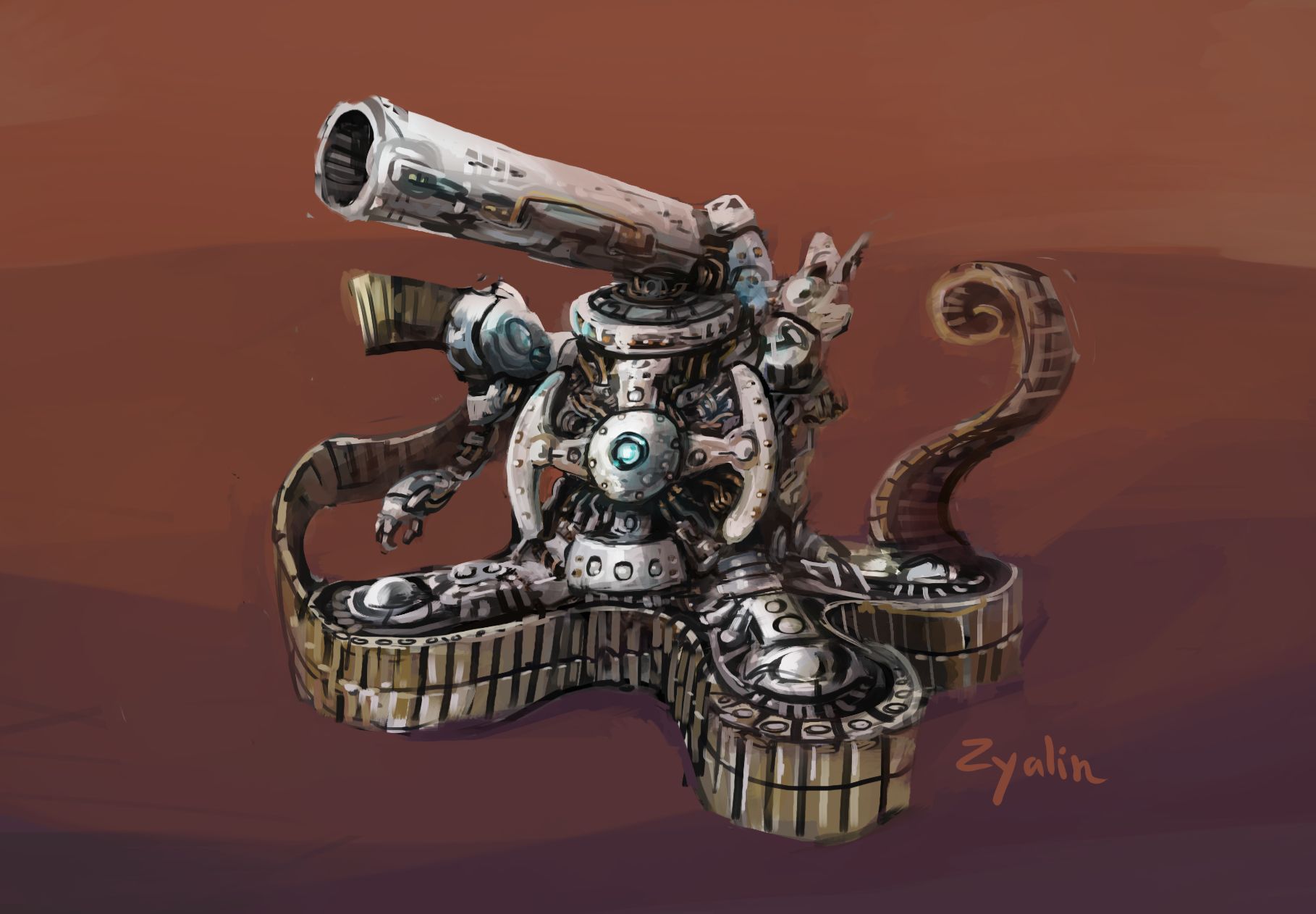
Zyalin’s impression of a Cogmind in siege mode.
Naturally we have some data on that mechanic in the scoresheets, though it only really makes sense to examine it from a depth of -6 and higher, since before that it’s relatively rare or difficult to even find treads large enough for siege mode. So that means we’re only going to look at 41% of runs.
Within that subset of runs, 15.7% of them entered siege mode at least once. Among those, the average number of siege mode uses was 15.3 (the median was 7). A single run by Vectis had the highest number of siege mode activations: 154.
The longest recorded siege lasted 21,282 turns, where Nikolayag wasn’t actually doing much of siege run, but only set up for it at the very end, simply finding a cozy place to sit in Access while firing a pair of Hypervelocity Railguns over 6,000 times at incoming high security assaults :P (this won’t work anymore due to the sterilization mechanic, but it used to be a good way to attempt a near-infinite score farm).
Excluding that exceptional run, the average duration of each run’s longest siege was 76 turns (median: 50 turns).
While a number of siege users might opt for fewer propulsion slots, or mix their treads with other forms of propulsion, one run in particular by roguelike master GJ shows the advantage of filling six slots with siege-capable treads (including treads designed to excel in siege mode), which is even better than the best shields since it’s free damage reduction. In that run siege mode reduced the total incoming damage by 6,121, two or more times that found in most other siege runs. In fact, GJ also took the second-highest spot in that category with another run using the same approach. These two runs and another by alice_fexa were the only ones in Beta 9 in which over 10% of all incoming damage across the entire run was ignored due to siege mode.
Beta 9 also made an important change to critical strikes by splitting robot immunity to them into two separate categories, one for core and another for parts, allowing many more uniques and otherwise dangerous robots to have their parts be crit off, even if a strike against their core would not instantly destroy them. The aim was to hopefully make crit-focused builds more viable again (in the early days when crit immunity was practically non-existent this strategy was far too effective, hence the later nerf, which was applied without attention to nuance :P).
Reportedly players did want to take advantage of this adjustment and add more crit capacity to their builds, or even build around it again, and the data does seem to show that playing out. (The following data only looks at runs that reached at least -3, since by then players have had plenty of time and slots to greatly differentiate their build, so it should offer a clearer picture.)
Between Beta 8 and 9, the percentage of critical hits as a total of shots that hit robots increased from 4.6% to 5.5%, and the percentage of kills attributed to critical hits increased from 5.3% to 6.9%, both of these suggesting more players were using more crit-capable builds. Even more pronounced is the average number of parts destroyed by critical hits per run, which rose from 20 to 31.
Crits are back.
Special Modes
Beta 9 happened to include more special events than any prior beta release, one for Winter/New Years (2019), another for April Fools (2020), then another for Halloween (2020). Aside from a minority of frequent players who want to try out something new, most stick to the regular mode, as you can see here:
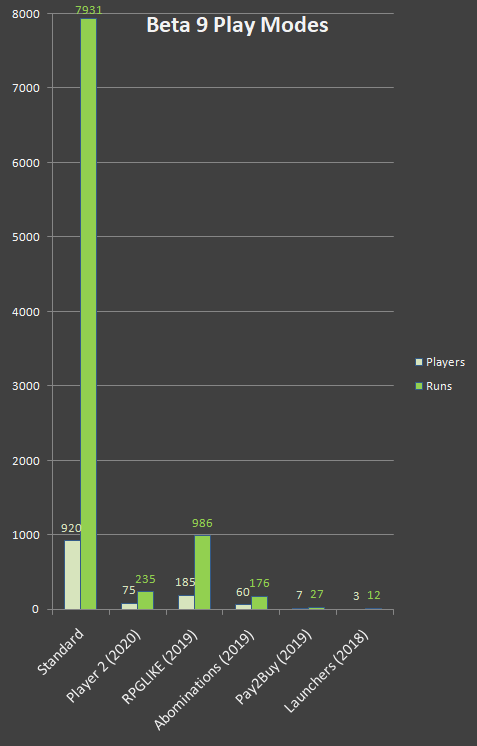
Pay2Buy and Launchers mode were not developed during Beta 9, but players can still go back and manually activate events after they’ve ended, including in most cases even those from previous years/versions.
The main exception is RPGLIKE, which some players use as designed, to be a permanent alternative way to play Cogmind with XP mechanics, leveling, and a common way to restore health to make it more like other roguelikes.
One piece of data I was particularly interested in with regard to RPGLIKE mode is how many people would chose to continue playing it after the relatively long automatic event period ended. Considering its nature, it probably wouldn’t drop off to practically nothing like the other modes, and indeed a small but non-insignificant number of players appear to have kept with it through the rest of Beta 9:
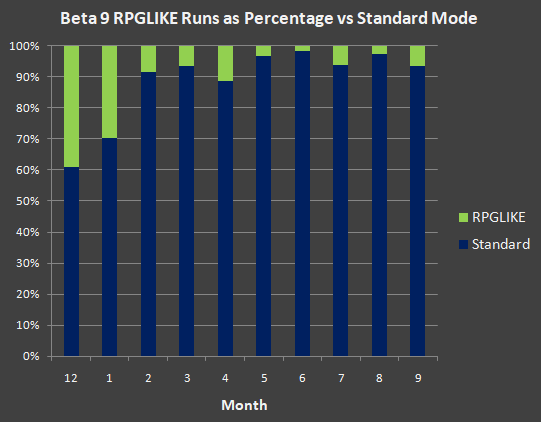
December/January are people playing during the event itself, when the mode was automatically activated for many players by default, and the spike in April was likely due to another mode released that month, reminding people that alternate modes exist and they can play earlier events they may have missed.
Here’s another comparison, showing instead the raw number of runs submitted each month:
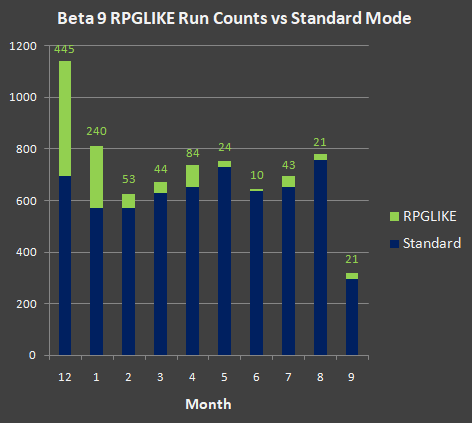
Explanation similar to the previous graph, although here it’s worth noting that September is cut short overall because Beta 10 was released that month.
It’s quite likely that even more players would chose to play (and stick with) RPGLIKE mode if it were included as a more prominent option instead of being relegated to occasional reminders in announcements or elsewhere (also there’s a tutorial message suggesting players try it if they’re looking for something like that), but it was a special event developed relatively quickly, so I don’t feel the mode is very representative of Cogmind’s quality overall (the design is hamfisted and difficulty level quite low) and I don’t want to promote it in a more “official” capacity. Thus it kinda lives in limbo where I’m at least glad some people can find (or be directed to) it when relevant, but that’s where it’ll stay for now :P
Since I didn’t get to analyze any mode-specific stats during Beta 9, let’s check out some of these as well…

Since the leaderboards were reactivated in 2020, I did put together separate boards for those who had played these Beta 9 special modes, each with access to scoresheets from individual runs as usual: Abominations, RPGLIKE, Player 2.
Abominations (2019)
Among those with score uploading active, 60 different players submitted 175 qualifying runs in Abominations mode, 14 of which went on to win.
That’s an 8% win rate, higher than the standard mode since many special mode players tend to be those with more experience and the goal for an short-term event would be to see as much as possible in as few runs as possible. Plus this mode only consists of ten (or fewer) floors, so generally shorter than a lot of normal complete runs.
Players destroyed an average of 17 Abominations per run, or 36 on winning runs, with Trione destroying the most in a single run (99) that ended in Research. sideriver81 won without destroying a single Abomination.
37% of hostile kills in winning runs were not Abominations, compared to 28% in non-winning runs, which might be somewhat meaningful strategically speaking in that killing 0b10 bots makes it overall less likely that the even deadlier Abominations will spawn, especially if using low-salvage atacks or the resulting free power sources are handled carefully. (For a look at how Abominations mechanics work and how the mode was designed, check out this article.)
Not many players destroyed Anomalies, although PhenomPhear took out 53 before escaping (the average number of Anomalies destroyed in runs that destroyed at least one was only 5--they can be very difficulty to hit, and also sometimes beneficial anyway depending on the type and circumstances).
14 runs visited the secret map, and 6 of those runs destroyed the boss there. Valguris destroyed the boss but was unable to escape afterward. 9 of the winning runs escaped through the surface instead.
RPGLIKE (2019)
185 unique players submitted 985 qualifying RPGLIKE runs throughout Beta 9, an average of 5.3 runs per player, and the median was only 2 runs (!), since many people just try a special event once or twice, while a handful of people will really enjoy it and play a lot, particularly in this case given the nature of the mode.
The top 10 most prolific RPGLIKE players alone accounted for 414 of the runs (42% of the total). badjay submitted the most runs, 69, playing 5~10 runs per week for a two-month period beginning when it was released, and Hermelin submitted 66 runs while playing off and on for an entire year. These didn’t include a lot of throwaway runs, either--many got quite far or scored highly as RPGLIKE is a somewhat easier mode with more ways to recover from mistakes and keep your build intact.
On the other end of the spectrum, of the 62% of players (115) who only played one or two runs, 16 won at least one run, a fairly high 13.9% win rate. (The win rate among all RPGLIKE runs was 8.8%.)
Because RPGLIKE mode goes against some core Cogmind design principles and makes it possible to essentially farm points indefinitely with a little bit of skill and familiarity with the mechanics, a significant 5.8% of runs (57) scored over 100,000, and even 8 runs scored over 200,000! By comparison these feats are extremely challenging to do in the regular game :P
One of the core features of RPGLIKE is gaining XP to raise levels, and the amount of XP gained diminishes the further ahead of the intended depth-based level curve the player reaches. (For this and many graphs and in-depth discussion of the RPGLIKE design, see my article on that.)
The max player level at the highest depth beyond which XP gains continue diminishing indefinitely is 31, though 14.8% of runs exceeded this level. The highest level ever reached was 39, an achievement shared by three different players: Phenom Phear, Valguris, and Terminus (who achieved this milestone on seven different runs xD). The lowest XP level win was by cptwinky, who escaped at only level 10 in a 906-turn speed run (and almost a pacifist win as well, if not for destroying an Excavator at the beginning and Sentry in Materials).
5.0% of runs didn’t even spend half of the XP earned, including many that went through several floors, and some even through a dozen or more! None of these runs went on to win, however. Winning runs spent an average of 94% of their XP. (One run by Solar Sloth did win despite spending only exactly 50% of their available XP.) The average percent of XP spent by all players was 84% (median 91%).
The highest number of upgrades in a single run was 134 by RezTeKK.
Slots are of course a popular upgrade since they’re versatile and the usual evolution process doesn’t occur, although they’re also more expensive in terms of XP, especially when stacking slots of the same type. An average RPGLIKE win had 21.2 slots (compared to a regular win in Cogmind, which always has at least 25 by the end). The greatest number of slots at win was 26 (the hard cap, achieved by several players), while the lowest number of slots was me, apparently the only player who submitted a run without upgrading any slots at all so I finished with only the 4 starting slots :P
With regard to other upgrades, they’re all useful, and every one was used to a large degree by at least someone--it’s mainly a choice of which each player would prefer for their build style and current condition, since the upgrades don’t generally offer brand new abilities, instead simply serving the same function as one or more other parts (only as abilities they are permanent and cannot be lost).
The average number of parts players actually lost in winning RPGLIKE runs is… a mere 3.8 xD. This is compared to 53 in regular wins (median: 42). Even non-winning RPGLIKE runs only lost an average of 2 parts. Clearly being able to repair your parts with Protomatter makes for more stable builds.
Among winning runs, an average 80% of Protomatter was used to repair core rather than parts (meaning any attached parts at the time were already at max integrity). Interestingly the average was 88% among non-winning runs, though it’s hard to draw specific conclusions from the disparity.
I’m sure we’ll still be seeing a number of RPGLIKE runs into Beta 10 and 2021; I’ll remain curious to see how that holds up :)
Player 2 (2020)
My personal favorite mode, Player 2 was also the most played among our short-term special events--75 players submitted 235 runs in all.
Player 2 (P2) runs have an extremely low 1.3% (!) win rate, however, with only 3 players making it to the surface, including cptwinky, GJ, and myself. Compared to other special modes it’s quite a unique challenge to win this one as it requires rather different strategies to increase the likelihood of success since you’re forced to work with a not-so-necessarily-cooperative partner for the entirety of the run.
They’re more likely to get themselves into trouble, although if you play to their strengths they are an incredibly powerful ally. Which is part of why the majority of runs had trouble controlling the resulting alert spiral as P2 obliterates everything and Cogmind either doesn’t contribute, or contributes and things get even crazier:
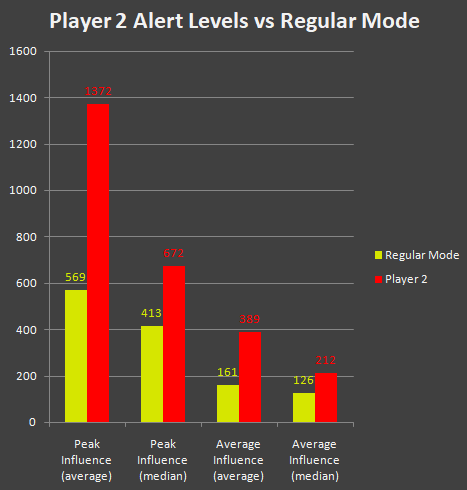
Player 2 clearly has a preference for combat, whether Cogmind likes it or not!
53.2% of runs reached an alert level of at least 4, which is when things can start quickly going downhill for the unprepared. 19.1% of runs ended in high or max security. Both these numbers are way beyond what we normally see in Cogmind, where 11.0% of runs hit that alert level, and only 2.4% end in high or max security.
On average P2 was responsible for destroying 52% of the combat bot kill rate in each run, and took 59.8% of the damage (being less worried about the need for defensive action :P). P2 lost an average of 32% of the parts they attached, but only 21% in the three winning runs (where those runs were more effective at either protecting P2, helping kill enemies before they could do significant damage, or finding/supplying better replacement parts quickly enough).
I enjoyed this mode from both a play and coding aspect, since building an AI capable of creating its own loadout like Cogmind and taking advantage of its abilities was a unique challenge in itself. I didn’t go back and write a dedicated article on this event, but its AI was born from an earlier Battle Royale project which I did write a bit about (the P2 AI is even more advanced).
Miscellaneous
Beta 8 added the Exiles, so it’s time to take another look at whether/how players’ interaction with that map changed from the earlier version (discussed in the Beta 8 stat summary). There are definitely some notable trends.
The number of runs visiting the Exiles dropped from 31.6% in Beta 8 to 24.9%, as they’re no longer the Hot New Thing (for new players coming to Cogmind with Beta 9, all maps are new maps, whereas back in Beta 8 a lot of existing players had been waiting eagerly for that kind of content).
Still that’s quite a few runs heading to the Exiles, more than a few of them with the intention of murdering everyone, as mentioned before. That said, the death rate in Exiles is lower in Beta 9 (1.5%) than Beta 8 (2.7%) as players develop more reliable strategies for surviving that choice (or knowing when they have no chance and shying away).
The number of winning runs visiting the Exiles stayed about the same (62.5%), but the number of winning runs stealing from the Exiles increased a good bit, from 11.3% in Beta 8 to 20.0%. Just in time for nerfs in Beta 11! (Most Exiles prototypes were introduced on the OP side, or at least some are serving a lot more than their original purpose :P)
19.3% of visitors stole from the Exiles, while only 4.8% were good and left with only one part, leaving a rather large 75.9% of visitors who were just passing through or decided not to take anything (or died trying to attack).
Looking at what players were choosing to take as their Exiles prototype (excluding theft, since those players just take anything and everything anyway), we have what is more or less a prioritization list of what’s best among their gear:
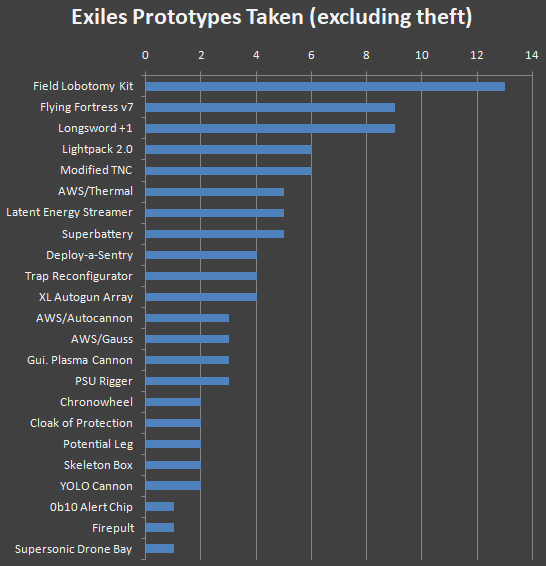
FLK, FF7, Longsword+1, and Lightpack are always popular.
Moving beyond Exiles to look at artifact use, 1.5% of runs used at least one “IR” (using the abbreviation for spoilers). That percentage increases to 15.8% among runs that reached a depth of -1, and yet further to 20.5% of all wins. An average of 1.8 IR were collected per run that used at least one, though the median use was 1. Ape used the most (8!) in a single run to win as an Alien-Scout. (Note: IR stats include only those used to help with parts.)
2.8% of runs acquired an “SR,” while 26% of runs that reached at least a depth of -1 acquired one. 47% of players never used theirs. So what did players use it on… (list is pretty SPOILERY if that matters to you):
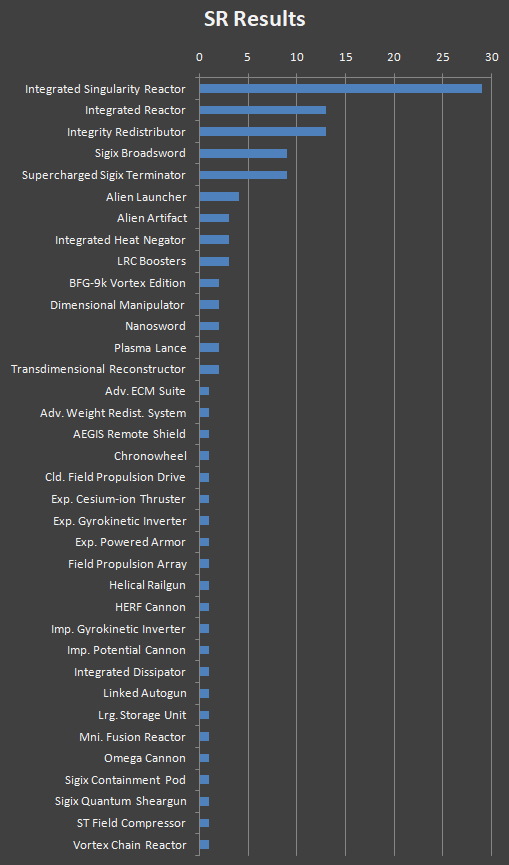
The clear winners here are obvious and expected, although sometimes players do have another pressing need. There are a couple unidentified alien items on the list which players used an SR on already essentially aware of what they were via meta knowledge.
Wow. If you’ve made it all the way down here you’re either a quick browser or just really love stats. If you want more stats of a different sort, check out Cog-Minder by aoemica, which has tons of data about in-game bots and parts, and has even recently been expanded with a detailed combat simulator!
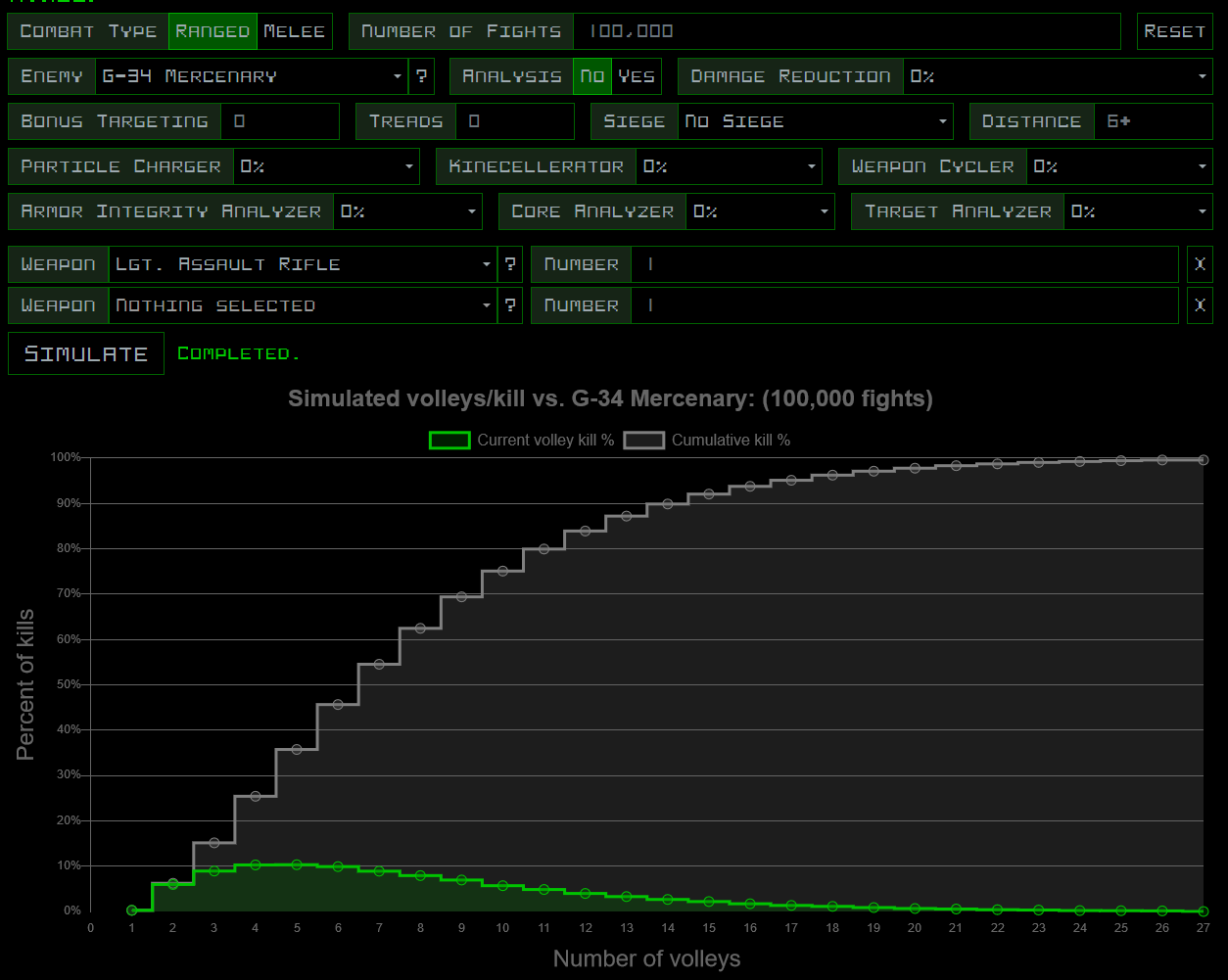
Cog-Minder simulator at work. Lots and lots of options, and it takes into account all kinds of mechanics.
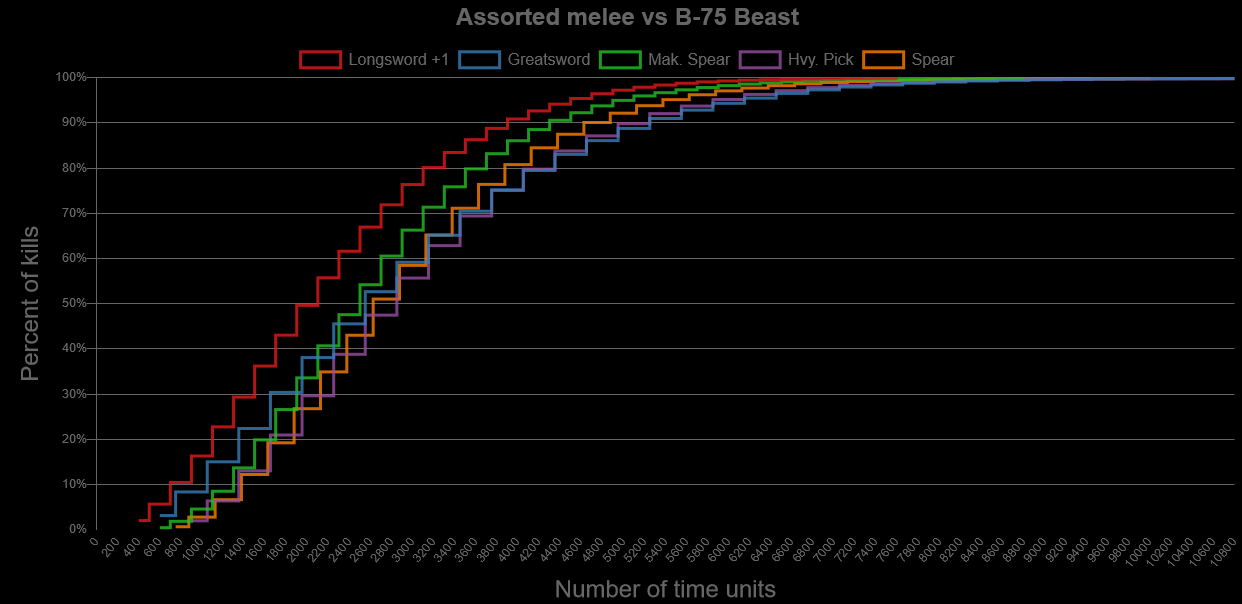
Cog-Minder weapon comparisons for effectiveness against different targets.
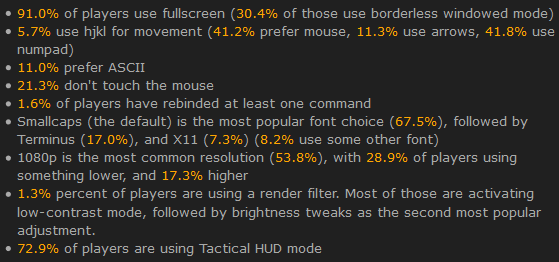
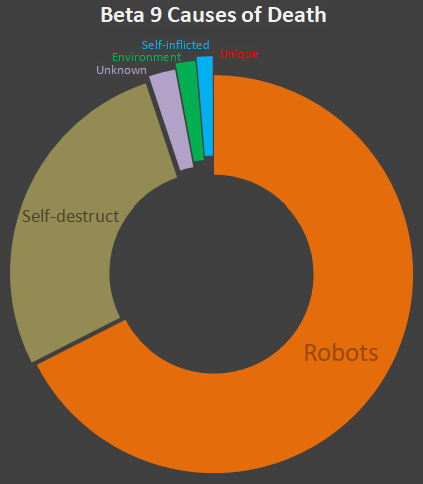
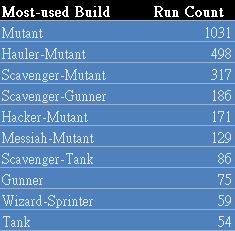
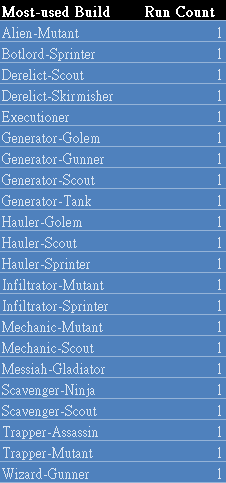
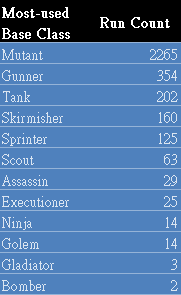
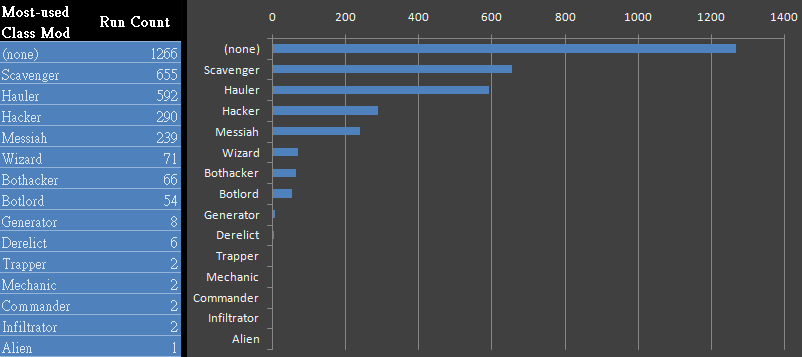
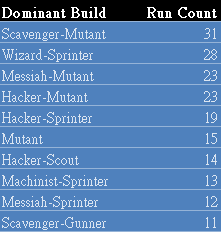
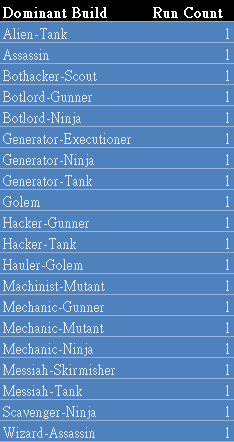
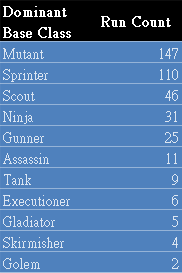
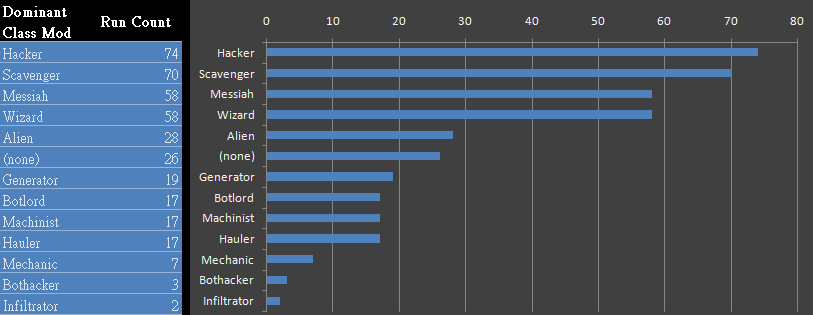


2 Comments
“from a mere one-tenth to nearly two-thirds” I think you meant “to over a third” ;)
Ah yeah, actually I was looking at the stats in a different way when I wrote the second part of that statement later on--kept getting interrupted (a lot) while trying to write this thing xD. Updated.